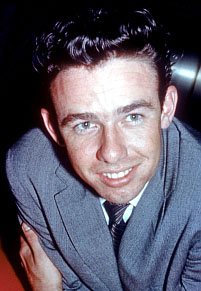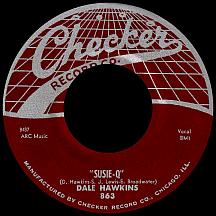DALE HAWKINS
Susie-Q
No quibbling over this one point: Dale Hawkins considered himself an "American roots person" as opposed to a straight rock and roller, hillbilly singer, R&B-based rocker or any other category people might try to put him in. Where music is concerned, the word "roots" has a wide definition and can be debated endlessly; roots music can be traced back hundreds of years or dozens, its name so ambiguous as to leave it with no clear-cut meaning. Still, Hawkins has been quoted as saying it's the term he prefers, though he was mostly influenced by southern blues singers and their diverse vocal- and guitar-playing techniques.
Gospel and black music in general served as an irresistible magnet for the youngster born Delmar Allen Hawkins, Jr. in 1936. He lived in Gold Mine, Louisiana, way down close to the Gulf more than 250 miles south of his eventual stomping grounds in Shreveport. His father and brother were also quite musical, but their tastes encompassed country while Dale was drawn to the voices of the black field workers in the area. Years after his father died in a fire, the family was living near Shreveport in Bossier City, where Dale delivered Grit newspapers and took other odd jobs, buying a guitar with the proceeds. After serving in the Navy, he became increasingly fascinated with the blues and R&B hits he heard on radio stations in the early- to mid-'50s. Name anyone from the era: blues guitar greats Gatemouth Brown and Lightnin' Hopkins, both of whom were skilled at other stringed instruments, or more radio-saturated personalities like piano man Fats Domino and vocal act extraordinaire The Dominoes. These were the types of artists he looked up to, in addition to a great many singers and musicians of the 1920s and '30s.
Friends and/or musicians of varying skill played in bands he put together including guitarist Fred Carter, bassist Frank Homer Kirkland and drummer Anthony J. Tuminello. Bobby Charles, a friend who'd recorded for Chess and charted the original "Later Alligator" in 1956 (Bill Haley's much bigger version added "See You" to the title), got Hawkins set up to record two songs with a bunch of available musicians after broadcast hours at local station KWKH; "See You Soon Baboon" (which opens with a Tarzan yell straight off the Johnny Weissmuller movies) and "Four Letter Word" ('...called rock!') were picked up by Leonard Chess and issued on the Checker label.
Dale's "Susie-Q" had little if any connection (beyond the title) to "Doin' the Suzie Q," a song based on a dance introduced at the Cotton Club in Harlem. Lil Armstrong (the second of Louis Armstrong's four wives) wrote and recorded it ('...now you swing over here, now you swing over there...you swing on out and you do the Suzie Q...you're dancin', you're prancin'...') for Decca in 1936. Variations on the song and dance made their way onto shellac discs over the years, including John Lee "Sonny Boy" Williamson's "Suzie Q" on Bluebird in 1938. A country song titled "Susie Q" appeared on the Time label in 1950 by the Allender X.I.T. Band with vocalist Pete Wilborn.
An early radio station version of Dale's "Susie-Q," done in a jazz/R&B style and featuring Shelton Bissell on saxophone and 16-year-old James Burton on guitar, was committed to tape sometime in 1956; credited co-writer Stanley J. Lewis claimed he named it after Leonard Chess's daughter Susan. Dale wasn't happy with the result and kept trying until it sounded the way it did in his head. The more rocking hit take (with drums and cowbell on the opening bars) was laid down in February 1957 by no less than ten musicians (not counting hand-clappers and support-team loiterers) and featured an electric bass line by James "Sonny" Trammell that gave the song a unique sound for the time. Released about three-quarters of a year after "Baboon," this fated-to-be-a-rock classic (and often-remade) recording of "Susie-Q" lingered on the charts from June to October '57, spending three weeks in the top 30 in the early going. Dale lip-synced his hit on American Bandstand's second national episode in August.

Burton didn't stick around - he joined Bob Luman's band shortly after the session. Later he spent about a decade as Ricky Nelson's lead guitarist and contributed to a large quantity of Rick's biggest hits. Sisters Margaret and Rose Lewis, regulars on the Louisiana Hayride shows that originated from Shreveport, met Hawkins around this time and frequently supplied backing vocals. Georgia-born brothers Dean and Marc Mathis (who later landed on the charts with "Tell Him No" as Dean and Marc and several years down the road made up two-thirds of The Newbeats) also backed Hawkins for a time. Sheldon Studio in Chicago became a regular spot to lay down new sides; the bigger-city studio didn't prevent them from rocking southern style and using more cowbell. Excuse us all for thinking of Dale in rock terms! Roots schmootz...tunes like "Baby, Baby" and "Tornado" sounded, then and now, like rock and roll, though with an ambiance unlike other period acts.
A second big Hawkins hit came to life at KWKH in June 1958. The quirky "La-Do-Dada" (sung 'Lot-n-dot-n-da-da...') racked up three weeks in the top 40 in October. Electric guitar whiz Roy Buchanan played on this and other tracks and had no qualms about bailing on prior commitments to join Dale's group on the road. At least 20 sides in the coming months sported Buchanan's lead axe, including a hot remake of Little Walter's '55 smash "My Babe." "A House, a Car and a Wedding Ring" (an early composition by "Apache" man Jerry Lordan) was recorded by British singer Mike Preston; Dale's cover skirted the bottom edge of the U.S. charts in November and December '58.
Meanwhile, family members were not-so-quietly getting in on the act. Dale's brother, Jerry Hawkins, did three singles for Ebb, some of them solidly rocking little numbers including "Swing Daddy Swing" and "Cha Cha Chu" (later, Jerry headed the Shreveport Federation of Musicians). Cousin Ronnie Hawkins, from Huntsville, Arkansas, qualified for rock immortality with a pair of '59 hits on Roulette: "Forty Days" and "Mary Lou." Back in Chicago, Dale waxed a song Dicky Stop (real name: Richard Toops) had out at the time; "Class Cutter," identified on many pressings as "Yea-Yea (Class Cutter)," was his most juvenile single yet ('...they kicked that fool right out of school,' he quipped). It spent several weeks just below the national top 50 in the spring of '59.
Doing sessions in different cities seemed to suit Dale; he trekked to Chicago, New York, Philly and locations in between, then back to Shreveport with strong results ("Liza Jane" in '59, "Hot Dog" and "Poor Little Rhode Island" in '60) but no further hits. He became a regional TV star in 1960 as the host of The Dale Hawkins Show (a daily teen-appeal dance gathering similar to Bandstand) on WCAU channel 10 in Philadelphia. But he was off the Chess-Checker roster by early '61. The Lewis Sisters changed course and focused more on songwriting (Margaret's best-known song is "Reconsider Me," cowritten with Myra Smith, a hit for Johnny Adams in 1969). Roy Buchanan quit to play with less-high-profile bands at about the time Dale's Chess contract ran out. At age 48, in 1988, a question arose as to whether he was murdered in a Fairfax, Virginia jail cell or committed suicide by hanging himself.
Dale began recording at Owen Bradley's quonset hut studio and other Nashville locations. Three 45s appeared on the Tilt label (The Drifters' classic "Money Honey" and a bouncy "Forbidden Love," both more teen-styled than previous works, plus a two-part party disc, "Hawk Blows Band Plays"). He made two dissimilar singles for Atlantic: "Stay at Home Lulu," a poppish Bob Crewe tune, and "Women - That's What's Happening!," a welcome blues exercise. Then "Peaches," on the Zonk label, went where other D.H. records hadn't (spoken vocals) while inducing hunger pangs for fuzzy fruit.
Around 1964, Dale began working in music production and turned out hits for the following artists: The Uniques ("Not Too Long Ago"), The Five Americans ("I See the Light," "Western Union"), Jon and Robin and the In Crowd ("Do it Again a Little Bit Slower") and Bruce Channel ("Mr. Bus Driver"). Occasionally making his own singles for ABC-Paramount, Abnak, Bell and other labels, in 1968 he moved in a corporate direction with RCA Victor. Yet while presiding over quality output by the likes of Harry Nilsson and ex-Monkee Michael Nesmith, it must have occurred that his quest had taken him a bit too far from his true love: the "roots" music that had shaped his great early recordings...the ones fans still obsess over these many years later. He returned to the Shreveport area in the early 1970s and later lived in Little Rock, Arkansas. Dale Hawkins died in 2010, hopefully aware of the permanent effect he'd had on rock and roll music. Or whatever you prefer to call it.


